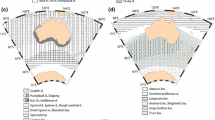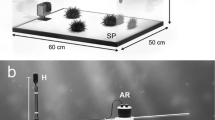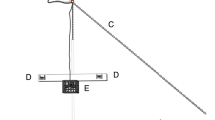Abstract
Despite the abundance and ecological importance of sea urchins in eastern Australia, it is not known how they may contribute to ambient noise. The sounds of feeding of two temperate and two tropical species were recorded in captivity. Most sound was produced between 2.3 and 9.2 kHz, but there were differences between species and substrate types.
Access this chapter
Tax calculation will be finalised at checkout
Purchases are for personal use only
Similar content being viewed by others
References
Alvarado JJ (2008) Seasonal occurrence and aggregation behavior of the sea urchin Astropyga pulvinata (Echinodermata: Echinoidea) in Bahia Culebra, Costa Rica. Pac Sci 62:579–592. doi:10.2984/1534-6188(2008)62[579:Soaabo]2.0.Co;2
Andrew NL, Underwood AJ (1989) Patterns of abundance of the sea urchin Centrostephanus rodgersii (Agassiz) on the central coast of New South Wales, Australia. J Exp Mar Biol Ecol 131:61–80
Au WWL, Banks K (1998) The acoustics of the snap** shrimp Synalpheus parneomeris in Kaneohe Bay. J Acoust Soc Am 103:41–47
Byrne M, Andrew N (2013) Centrostephanus rodgersii. In: Lawrence JM (ed) Sea urchins: biology and ecology, vol 38, Developments in aquaculture and fisheries science series. Elsevier, London, pp 243–256
Everest FA, Young RW, Johnson MW (1948) Acoustical characteristics of noise produced by snap** shrimp. J Acoust Soc Am 20:137–142
Fish MP (1964) Biological sources of sustained ambient sea noise. In: Tavolga WN (ed) Marine bio-acoustics. Pergamon, Oxford
Foster SA (1987) The relative impacts of grazing by caribbean coral reef fishes and Diadema: effects of habitat and surge. J Exp Mar Biol Ecol 105:1–20
Johnson MW, Everest FA, Young RW (1947) The role of snap** shrimp (Crangon and Synalpheus) in the production of underwater noise in the sea. Biol Bull 93:122–138
Jones GP, Andrew NL (1990) Herbivory and patch dynamics on rocky reefs in temperate Australasia: the roles of fish and sea urchins. Aust J Ecol 15:505–520
Leis JM, Lockett MM (2005) Localization of reef sounds by settlement-stage larvae of coral-reef fishes (Pomacentridae). Bull Mar Sci 76:715–724
Ling SD, Johnson CR, Ridgway K, Hobday AJ, Haddon M (2009) Climate-driven range extension of a sea urchin: inferring future trends by analysis of recent population dynamics. Global Change Biol 15:719–731. doi:10.1111/j.1365-2486.2008.01734.x
Radford C, Jeffs A, Tindle C, Montgomery JC (2008a) Resonating sea urchin skeletons create coastal choruses. Mar Ecol Prog Ser 362:37–43. doi:10.3354/Meps07444
Radford CA, Jeffs AG, Montgomery JC (2008b) Orientated swimming behaviour of crab postlarvae in response to reef sound. Bioacoustics 17:87–89. doi:10.1080/09524622.2008.9753776
Radford CA, Stanley JA, Simpson SD, Jeffs AG (2011) Juvenile coral reef fish use sound to locate habitats. Coral Reefs 30:295–305. doi:10.1007/s00338-010-0710-6
Shepard SA (1973) Competition between sea urchins and abalone. Aust Fish 32:4–7
Simpson SD, Meekan MG, Jeffs A, Montgomery JC, McCauley RD (2008) Settlement-stage coral reef fish prefer the higher-frequency invertebrate-generated audible component of reef noise. Anim Behav 75:1861–1868. doi:10.1016/j.anbehav.2007.11.004
Strain EMA, Johnson CR (2009) Competition between an invasive urchin and commercially fished abalone: effect on body condition, reproduction and survivorship. Mar Ecol Prog Ser 377: 169–182. doi:10.3354/meps07816
Tolimieri N, Jeffs A, Montgomery JC (2000) Ambient sound as a cue for navigation by the pelagic larvae of reef fishes. Mar Ecol Prog Ser 207:219–224
Trenkel V, Ressler P, Jech M, Marianna G, Chris T (2011) Underwater acoustics for ecosystem-based management: state of the science and proposals for ecosystem indicators. Mar Ecol Prog Ser 442:285–301. doi:10.3354/meps09425
Tuya F, Boyra A, Sanchez-Jerez P, Barbera C, Haroun R (2004) Can one species determine the structure of the benthic community on a temperate rocky reef? The case of the long-spined sea-urchin Diadema antillarum (Echinodermata: Echinoidea) in the eastern Atlantic. Hydrobiologia 519:211–214
Vermeij MJA, Marhaver KL, Huijbers CM, Nagelkerken I, Simpson SD (2010) Coral larvae move toward reef sounds. PLoS ONE 5, e10660. doi:10.1371/journal.pone.0010660
Acknowledgments
This research was supported by a fellowship from the Sydney Institute of Marine Science (SIMS). SIMS publication number 155.
Author information
Authors and Affiliations
Corresponding author
Editor information
Editors and Affiliations
Rights and permissions
Copyright information
© 2016 Springer Science+Business Media New York
About this paper
Cite this paper
Soars, N., Byrne, M., Cato, D.H. (2016). Characterization of the Sounds Produced by Temperate and Tropical Sea Urchins During Feeding (Diadematidae and Echinometridae). In: Popper, A., Hawkins, A. (eds) The Effects of Noise on Aquatic Life II. Advances in Experimental Medicine and Biology, vol 875. Springer, New York, NY. https://doi.org/10.1007/978-1-4939-2981-8_133
Download citation
DOI: https://doi.org/10.1007/978-1-4939-2981-8_133
Publisher Name: Springer, New York, NY
Print ISBN: 978-1-4939-2980-1
Online ISBN: 978-1-4939-2981-8
eBook Packages: Biomedical and Life SciencesBiomedical and Life Sciences (R0)




